Antontsev S.N., Kazhikhov A.V., Monakhov V.N. Boundary Value Problems in Mechanics of Nonhomogeneous Fluids
Подождите немного. Документ загружается.


Chapter
5
-+
lfy
5
M.
(9.21)
Then
,
Here
u(x,
t)
=
ao(t;)cg,
0
<
u51/2,
uo
>
0,
and a constant
C
only depends on
lii,
(Y,
01"
and the diatance to the boundary.
Proof. The conditions of the theorem and estimate
(9.9)
due to
imbedding theorems result
in
0
(9.23)
0:
(s(t,
x,)
-
s(t,
x211
I
C~X,
-
xpl
,
o
<
a
I
l/r
i;
>
0,
(XI,
x2)
E
n.
Considering the equation (8.2) for
2(x,
t)
-+
div(I<(A,
s)~
p
+
i(x,
s))
=
0,
-+
we obtain that
(~(x,
t)
E
I<[,:,
s(s,
t)],
f(--,
t))
E
L.
JO,
Yj
c'(Qf)
J
n
L
,[O,
P;
.J;(Q*)]
and consequently, by theorem 4.3
P(X,
t)
E
L
,[o,
T;
,iZ(ni)]
n
L
,lo,
I;
C~+~(Q~)],
2
<
c1
<
4,
'1.
i.e.
riable
x.
The function
U(X,
t)for which (9.23)
is
obviously valid
too would be the solution of the equation
(9.17)
with coefficients
p(x,
t),
px(x,
t)
are continuous due
to
Holder over
a
va-
satisfying (9.18). Consequently, by lemma 9.1
u(x,
-t)EC
%a,''(
2
fcI
J
(
,i
I
j
.
On account
of
the first
of
inequalities (9.2)
(Iinla''1
5
5
lu,)
now
it
follows that
s(x,
tj
=
s[.J(x,
tj]E
85(.,,1)
it
means that
in
respect to theorem
4.5
p(x,
t),
px(x,
t)
setisfies
the kHolder condition over
a.
variable
.t
too. The theorem has been
completely proved.
4.
Uniqueness of solution
In the case
of
a joint system
(8.71,
(8.2) the following in a de-
finite sense relative uniqueness theorem
is
valid.
Theorem 9.4. Let
in
addition to conditions (i)
-
(iii) 82
(con-
ditions
of
existence theorem)
I
11
j
A<,
.;
iC
S
;
fAj
b'l
I
LA,
(9.24)
KO(x)
E
Cm)
end
k(s)
satisfies the inequality (4.15) with
<
1.
Then, generalized (in terms of definition 2.1) solutions
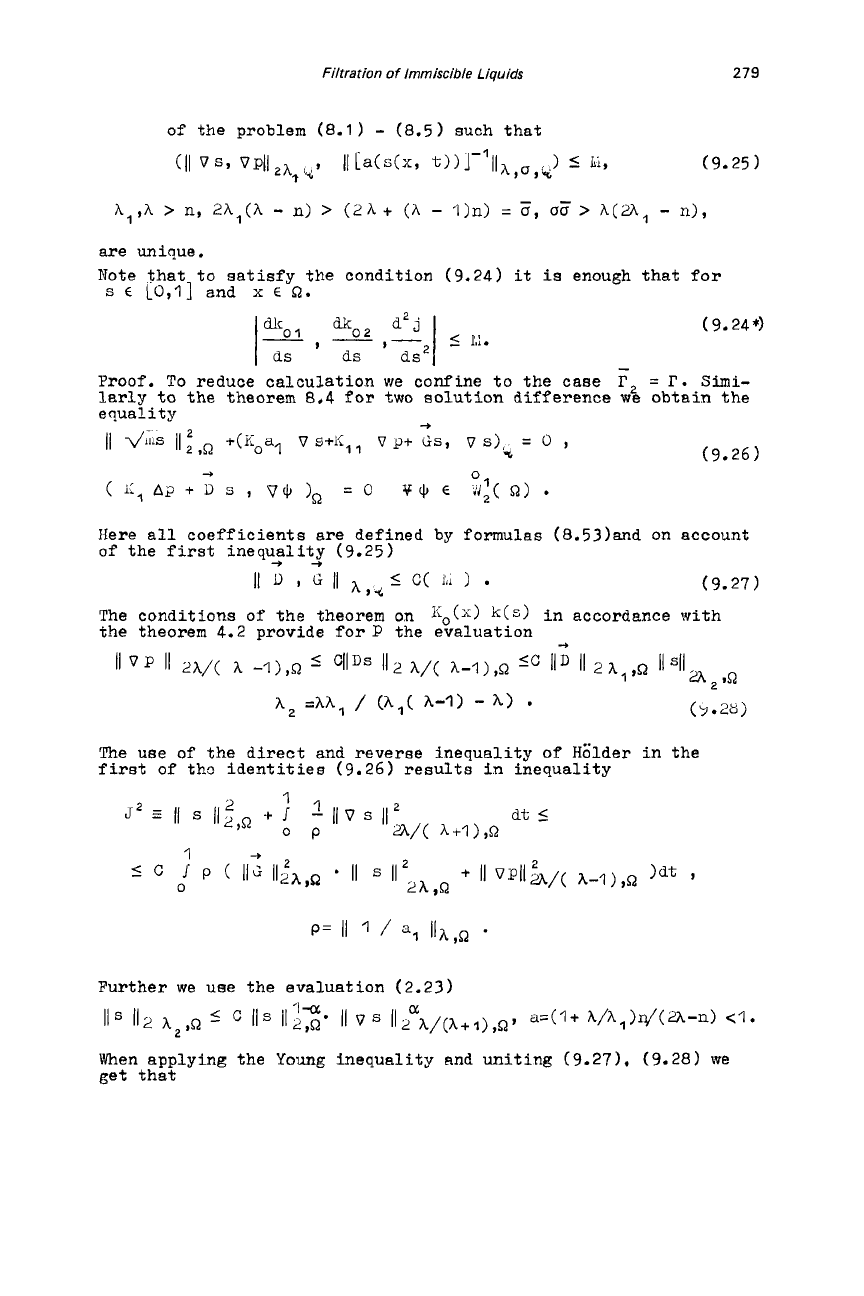
Filtration of Immiscible Liquids
279
of
the problem
(8.1)
-
(8.5) such that
(I1
v
SY
vPl12h,,,d1
II
[a(s(x,
t))l-lllAya,K)
5
LY
(9.25)
Al,A
>
n,
2Al(h
-
n)
>
(2A
+
(A
-
1)n)
=
(J,
ai?
>
A(U,
-
n),
are unique.
Note that to satisfy the condition (9.24)
it
is
enough that for
s
E
LO,l]
and
x
E
Q.
(9.24*)
-
Proof.
To
reduce calculation we confine to the case
I'
=
I?.
Simi-
larly
to
the theorem
8.4
for
two
solution
difference
wk
obtain the
eouali
ty
--t
11
dills
11
2'
rQ
+(?Lodl
v
s+i<,,
v
p+
GS,
v
s),
=
o
9
%
(9.26)
+
(
I:,
A?
+
U
s
,
VJ,
)Q
=
0
if+
E
:/:(
Q)
.
Here all coefficients are defined by formulas (8.53)and on account
of
the first inequality (9.25)
++
11
0
8
G
11
A,.<-
c(
(9.27)
The conditions of the theorem
on
lLo(x)
k(s)
in accordence
with
the theorem
4.2
provide forP the evaluation
-+
11
vp
11
&I,/(
A
-1),Q
112
A/(
h-l),Q
"
IID
11
2A1,Q
IIsI/ah,,Q
Ah,
=Ah,
/
(A,( A-1)
-
1)
*
(Y.23)
The use of the direct and reverse inequality
of
Hb'lder in the
first
of
the identities (9.26) results in inequality
Further we uee the evaluation (2.23)
11s
112
When applying the Young inequality Rnd uniting
(9.271,
(9.28) we
get that
CL
5
c
11s
lliz*
II
v
s
II~
A/(A+,),QV
a=(l+
A/Al)n/(a-n)
<I.

280
Chapter
5
because of
(9.25)
Consequently, finally owing to
(9.291,
(9.30)
and
(2.18)
2
ch.
I
we have
Remark
I.
The
last
of
the inequalities
(9.25)
imposes
a
priori
co
di,
ion
o
t
e orde
of
conversion into zero the coefficient
u&f~,h
a?
sk~
t
Ifin the sought solution.
In
some cases this
condition
is
effectively verified before the problem solution.
consider, for instance the problem
&t
=
div
(Lo"
Vs)
Y(t)
=
(Is
11;,&
=
0
.
b'
vp
vs
,
Lo
n
vs.
-?I
Ir
=
0,
s
It=o
=
so
Multiplication of the equation by
a-'(s)a'(
s)
tion by parts results in the equality
followed by integra-
and for
y
>I,
utL<0
respectively in evaluation
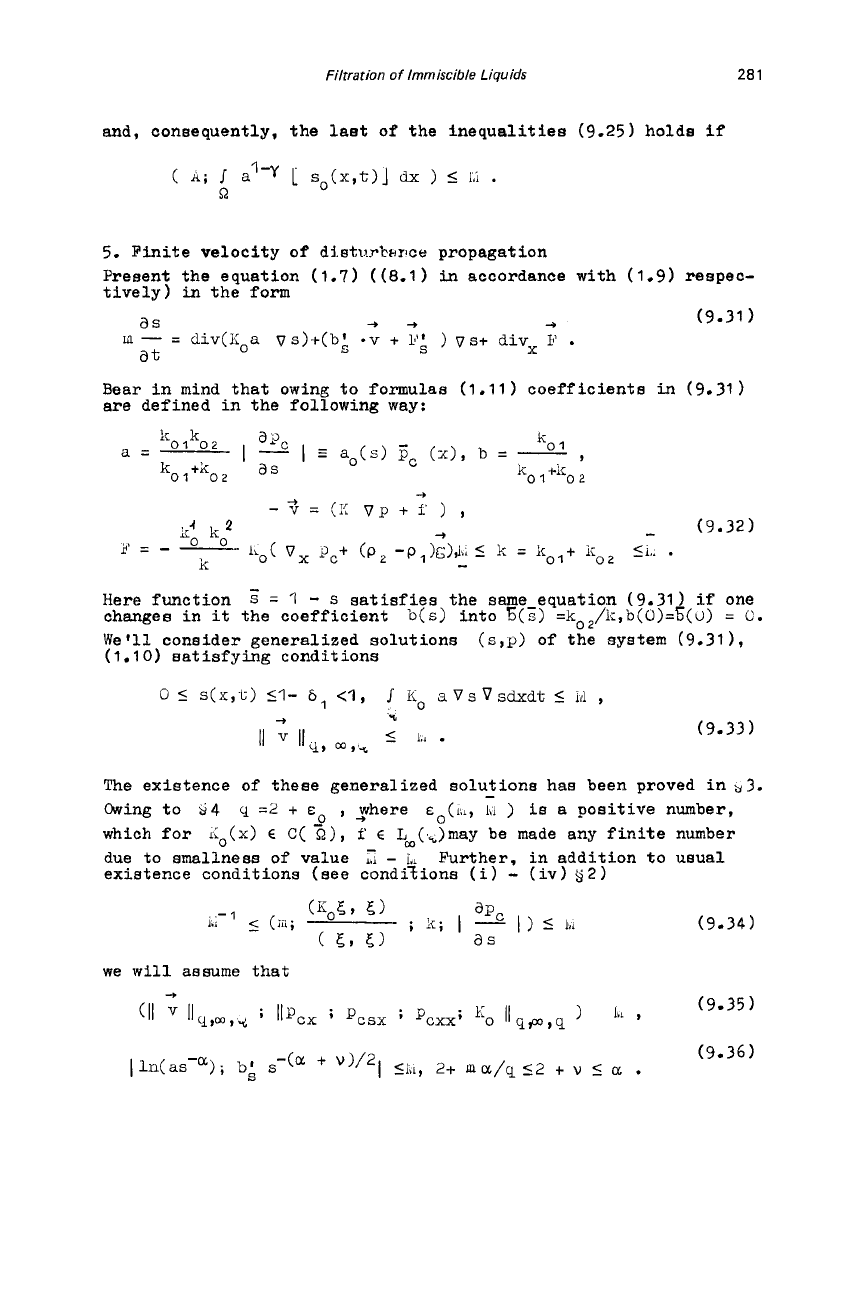
Filtration
of
lmm
iscible
Liquids
28
1
and, consequently, the
last
of
the inequalities (9.25) holds
if
(
Ki
I
a"Y
c
s,(x,t)l
cl~
1
5
~,i
.
Q
5. Finite velocity
of
dJ stvrbmce propagation
Present the equation (1.7)
((8.1)
in
accordance with (1.9) respec-
tively)
in
the form
+-?
+
(9.31)
10.
-
=
div(iCoa
gs)+(bA
-v
+
b';
)
gs+
divx
3'
.
Bear in mind that owing to formulas
(1.11)
coefficients
in
(9.31)
are defined in the following way:
as
at
lr
xLolko2
a-3,
-
ko
1
kol+ko2
as
Ic
01
CISo
a=-
I- I
E
ao(s)
pc
(x),
b
=
-
,
-
Here function
change8 in
it
the coefficient
We'll consider generalized solutions
(s,p)
of the system (9.31
1,
(1.10)
satisfying conditions
s
=
1
-
s
satisfies the same-equation (9.31)
if
one
D(S)
into
s(s)
=ko,/i;,b(0)=6(O)
=
C.
(9.33)
The existence
of
these generalized solutions
has
been proved in
33.
Owing to
~4
q
=2
+
.so
,
yhere
E~(I.,,
l\i
)
is
a positive number,
which for
i0(x)
E
C(
z),
f
E
L,(%)may be made any finite number
due to smallness of value
-
I.~
Further, in addition
to
usual
existence conditions (see conditions
(i)
-
(iv)
~2)
-
(9.34)
we
will
assume that
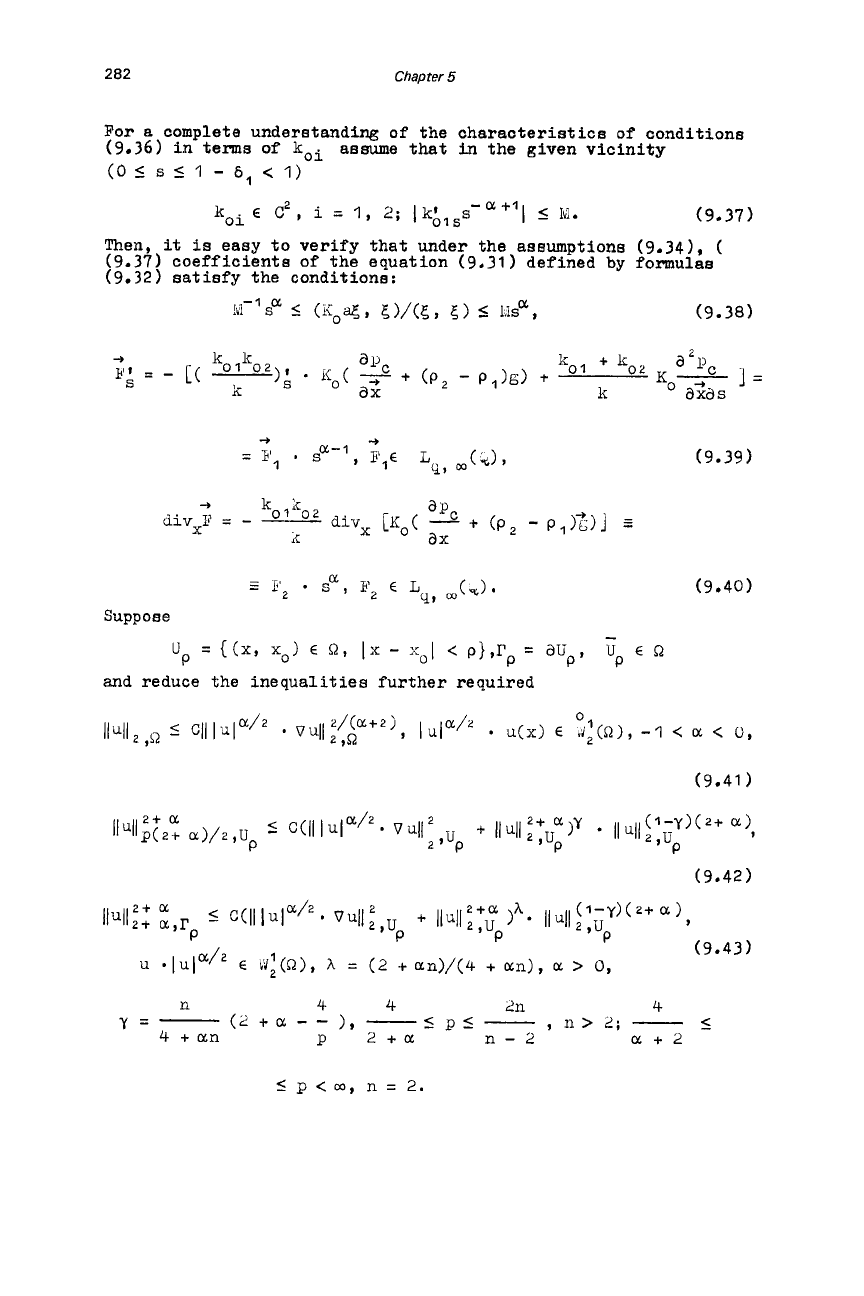
202
Chapter
5
For
a complete understanding of the characteristics of conditions
(9.36)
in terms
of
koi
assume
that
in
the given vicinity
(OSs51
-6,<1)
I
5
IU.
(9.37)
s-
CL
+I
k
.
E
C2,
i
=
1,
2;
Ikhls
01
Then,
it
is
easy to verify that under the assumptions
(9.341,
(
(9.37) coefficients of the equation
(9.31)
defined
by
formulas
(9.32)
satisfy the conditions:
J',
*
SO",
P,
E
Lq,
m(x).
Supp
0s
e
-
up
=
{(x,
x0>
E
Q,
IX
-
x~I
<
p},rp
=
auP,
u
E
Q
P
and
reduce
the
inequalities further
required
(9.40)
n
4
4
Ln
4
(2
+
CL
-
-
),
-
5
p5
-
,
I1
>
2;
-
<-
4 +an
p
2+u.
n-2
CL+2
y=-
5
p
<
m,
n
=
2.
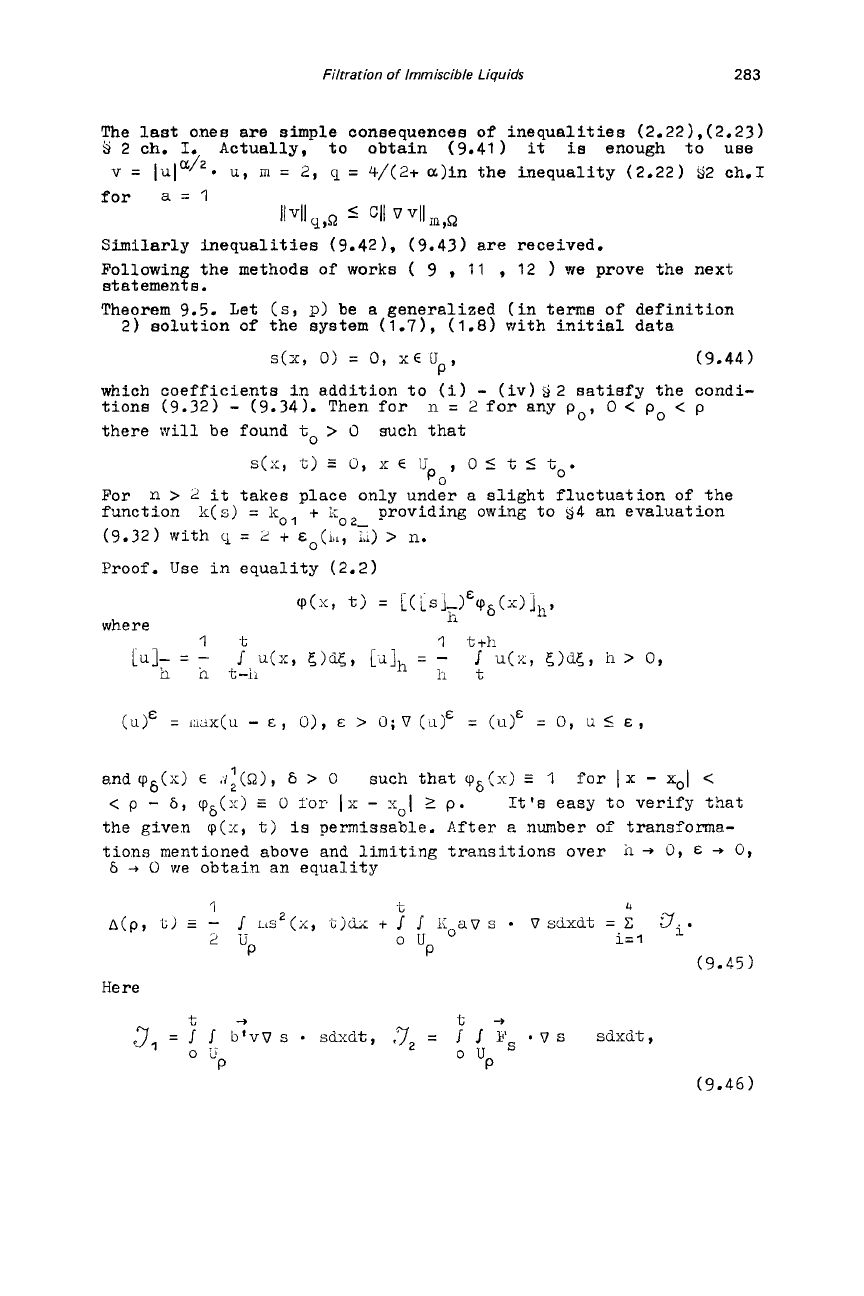
Filtration
of
immiscible
Liquids
283
The
last
ones are simple consequences
of
inequalities (2.22),(2.23)
$
2
ch.
I.
Actually, to obtain (9.41)
it
is
enough to use
v
=
1u1O1''*
u,
m
=
2,
q
=
4/(2+
a)in the inequality (2.22) $2 ch.1
Similarly inequalities (9.421, (9.43) are received.
Following
the methods of works
(
9
,
11
,
12
we
prove the next
statement
8.
Theorem 9.5. Let
(s,
p)
be a generalized (in terms
of
definition
2)
solution
of the system (1.71,
(1.8)
with initial data
(9.44)
P'
s(1,
0)
=
0,
XE
u
which coefficients
in
addition to (i)
-
(iv)
$2
sstisfy the condi-
tions (9.32)
-
(9.34). Then for
there
will
be
found
to
>
0
such that
n
=
2
for any
po,
0
<
p,
<
p
S(L,
t)
E
0,
>:
E
lj
,
0
5
t
6
to.
Po
For
n
>
2
it
takes place only under a slight fluctuation
of
the
function
b(s)
=
k0,
+
1:
(9.32) with
cl
=
2
+
~~(i,,,
,,,)
>
n.
Proof. Use
in
equality (2.2)
providing
owing
to
34
an evaluation
0
2-
cp(x,
tl
=
l(LsL)Ecp6(dlh,
IL
where
It
1
t+h
[u]-
=
-
I
U(%,
5)G,
4
=
-
I
u(x,
5)dE'
n
>
0,
h
fl
t-11
11
t
(U)E
=
,d;x(u
-&,
O),
E
>
U;V(Ll)&
=
(Uy
=
0,
u<
E,
8.nd
cp6(:;)
E
.i;(Q),
6
>
0
the given
q(x,
t)
is
pernissable. After
e
number
of
transforma-
tions mentioned above and limiting transitions over
I?
-t
0,
E
-t
0,
such that
cp,(x)
=
1
for
Ix
-
xol
<
<
p
-
6,
cp6(::)
E
o
for
JX
-
Y
I
2
p.
It's
easy to verify that
6
4
0
vie
obtain
an
equality
t+
t-t
05
ou
J,
=
I
I
b'vv
s
sdxdt,
,y2
=
i
J
Fs
'V
s
sdxdt
,
P
P
(9.46)

284
Chapter
5
P'
n
-
normal to
I'
Use
t
A(p,
t>
=
f
u
s
dx,
B(p,
t)
=
f
I
ou
2
Koa
vs
vsdxdt,
P
(9.47)
where
to
>
0
almost all equalities are valid
is
an arbitrary number yet.
It
is
obvious that
for
aB
t
--
-
f
I
Koa
vs
vsdrdt
5
0,
ap
o
r
Q
(9.48)
a3
aa
at-$
P
0
aP aP
ost
<to
ap
aBo
=
aB(p'
to)
=
lli~x
-
li
a
vs
vsdx
I
0,
-
--
and in agreement with properties
of
a
generalized solution
Bt
E
L,(O,
TI,
13
E
LI(O,
p).
P
a-
Estimate addends
(9.35)
-
(9.371, (9.47) in the following way:
yfi
LE
1,
4,
in the right side (9.45) accounting
(9.52)
Let's apply inequalities (9.42). (9.43)
and
put them down with
the help
of
designations (9.471,
(9.48)
in
the
form

Filtration
of
Immiscible Liquids
285
(9.54)
y'
=
(1
-
y)(2
+
a),
A'
=
(1
-
h)(2
i-
a).
Assuming
p(2
+
a)/2
=
(2
+
v>q/(q
-
2)
with the
help
of
(9.53)
find
:
2+u
y y12(v+2)
-
t
5c
/(~~+a
2
12
A
a+
dt
5
lIS2+Vllqj(r;-a
1;
1
,up
x(0
,t)
0
Y
(v+2
1
N
y*(v+zj
2+
a
-I;
N
I
(S.t-
+
A>
N-
5C
A,
a
+'
dt
5
C(Ao
+
Bo>ot~X
5
0
5
C(Ao
+
Bo)tiX;
(9.55)
v+2
2+v
2+u
2
+u.
k)
=
-
(y'
+y)
2
1;
2x=
1
-y-
.
Hence, taking into account (9.40)
for
.yl
we come to the estimate
In
the completely eimilar
way
.?
',
;y
are estimated
lJil
5
C(Ao
+
Bo>t~,
i
=
2,
3.
The use
of
(9.54)
in
(9.52)
results in inequality
aB
t
aP
0
13,1
I
C(
-
)I/'(
J(Bt
+
g(z+
">/')>hAA'dt)
/
5
(9.57)
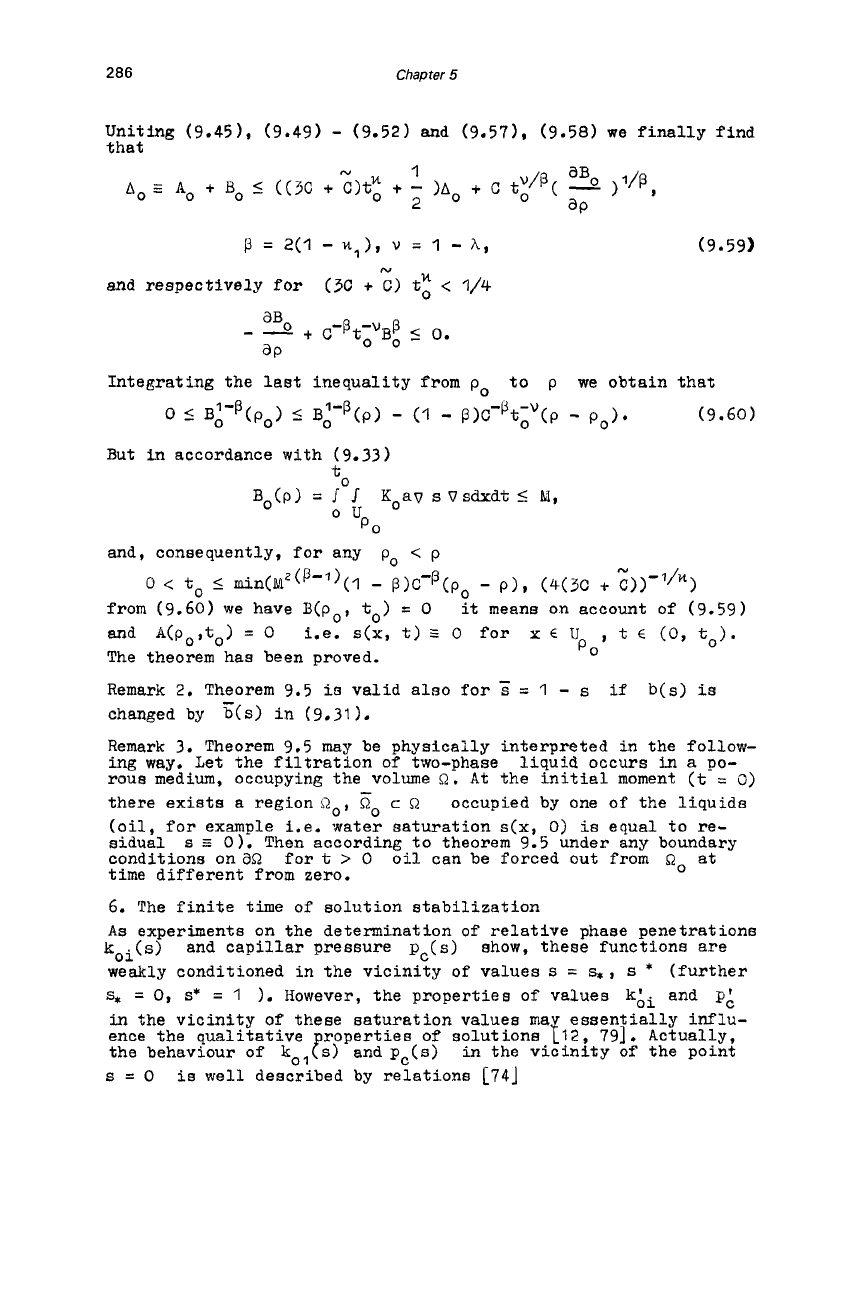
286
Chapter
5
Uniting (9.451, (9.49)
-
(9.52) and (9.571, (9.58) we finally find
that
p
=
2(1
-
M,),
v
=
I
-
A,
N
and
respectively for
(3C
+
C)
t:
<
1/4
(9.59)
Integrating the last inequality from
p,
to
p
we obtain that
(9.60)
0
5
BA-’(po)
5
B;-’(p)
-
(1
-
PIC
-p
to
-v
(p
-
p,).
But in accordance with (9.33
U
0
Bo(p>
=
f
I
ou
Koav
s
vsdxdt
5
M,
PO
and, consequently, for any
p,
<
p
0
<
to
I
min(M2(P’1)(1
-
p)C-p(po
-
p),
(4(3C
i.
;))-‘IH)
from
(9.60) we heve
B(po,
to)
=
0
and
A(po,to>
=
0
i.e.
s(x,
t)
5
0
for
x
E
U
,
t
E
(0,
to).
The theorem has been proved.
Remark
2.
Theorem 9.5
in
valid also for
s
=
1
-
s
changed by
b(s)
in
(9.31).
Remark
3.
Theorem
9.5
may be physically interpreted in the follow-
ing way. Let the filtration
of
two-phase liquid occurs
in
a
po-
rous medium, occupying the volume
Q.
At
the initial moment
(t
=
0)
there exists a region
Qo,
go
c
Q
(oil, for example i.e. water saturation
s(x,
0)
is
equal to re-
sidual
s
f
0
).
Then according to theorem
9.5
under any boundary
conditions on
as2
for
t
>
0
oil can be forced out from
Qo
at
time different from zero.
6.
The
finite time
of
solution stabilization
As
experiments on the determination
of
relative phase penetrations
koi(s)
and capillar pressure
p,(s)
show, these functions are
weakly conditioned in the vicinity
of
values
s
=
G,
s
*
(further
S,
=
0,
s*
=
1
1.
However, the properties
of
values
kAi
and
p:
in
the vicinity of these saturation values
ma
essentially influ-
ence the qualitative roperties
of
solutions
fl2,
791. Actually,
the behaviour of
ko,ts)
and
p,(s)
in
the vicinity
of
the point
s
=
0
it
means
on
account
of
(9.59)
PO
if
b(s)
is
-
occupied by one of the liquids
is
well
described by relations
(1741
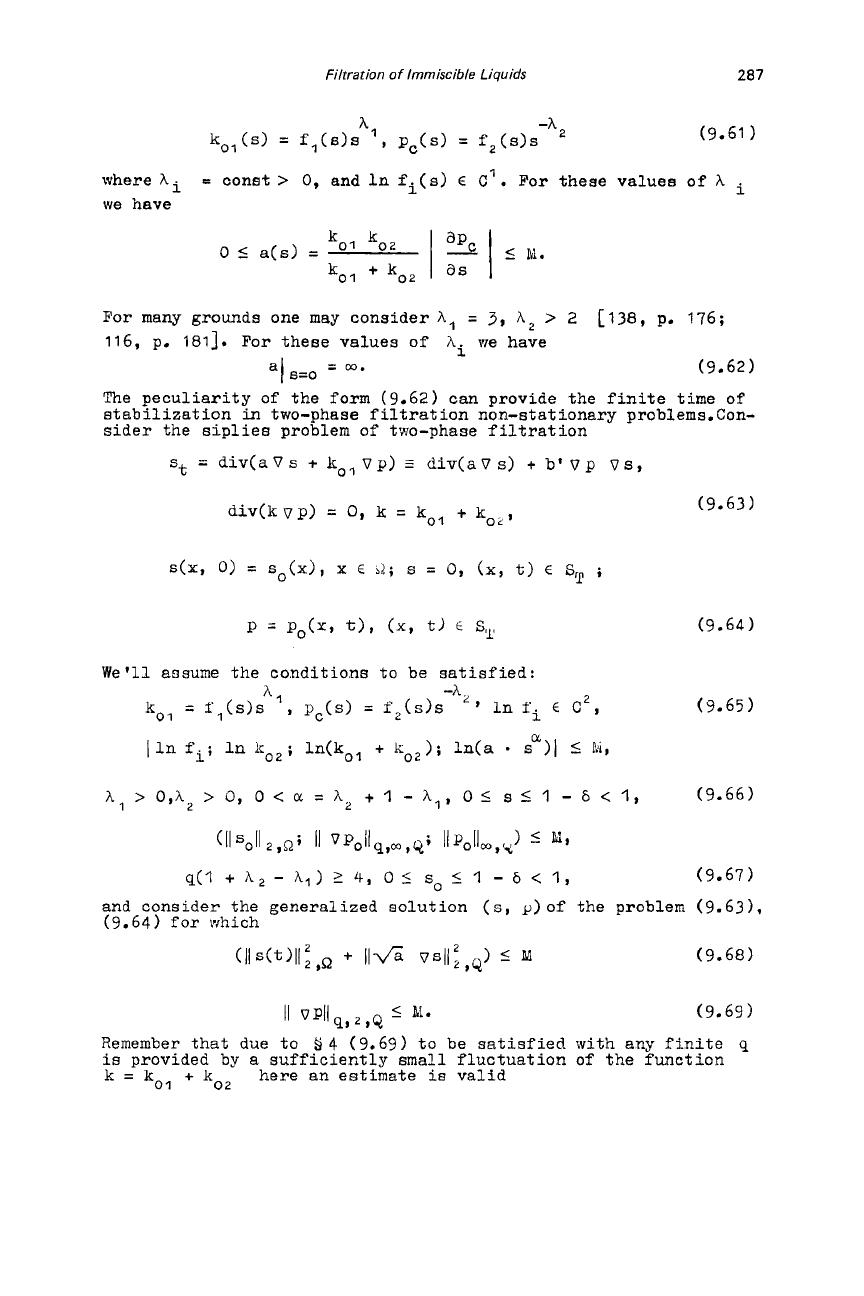
Filtration
of
immiscible Liquids
287
where
hi
we have
=
const
>
0,
and
In
fi(s)
E
C1.
For these values
of
h
For many grounds one may consider
A,
=
3,
h2
>
2
116,
p.
1811.
For these values of
hi
vie
have
a(
s=o
=
w.
(9.62)
The peculiarity of the form (9.62) can provide the finite time
of
stabilization
in
two-phase filtration non-stationary problems.Con-
sider the siplies problem of two-phase filtration
[138,
p.
176;
st
=
div(a0s
+
ko,,vp)
3
div(aVs)
+
b'vp
vs,
div(kvp)
=
0,
k
=
kol
+
ko2,
(9.63)
s(x,
0)
=
so(x),
x
E
a?;
s
=
0,
(x,
t)
E
ST
;
P
=
Po(&
t),
(x,
t)
sy
(9.64)
We'll assume the conditions to be satisfied:
(9.65)
A1
-A2
kol
=
fl(s)s
Iln
fi;
In
kO2;
ln(ko,
+
Lie,);
ln(a
-
s
)I
5
Li,
,
pc(s)
=
f,(s)s
'
In
fi
E
C2,
CL
hq>O,Az>0,
O<a=h2
+l-h1,05s51
-b<1,
(9.66)
CIISol12,Qi
II
vPollq,m,Qi
IIPOll",J
5
q(1
+
A2
-
A,)
2
4,
0
5
s
5
1
-
b
<
1,
(9.67)
0
and consider the generalized solution
(s,
p)of the problem (9.631,
(9.64)
for which
(IIs(t)IIi,Q
+
II<a
VSII:,~)
5
M
(9.68)
11
vdIq,z,Q
<
-
bl.
(9.69)
Remember
that
due to
84
(9.69) to be satisfied with any finite
q
is
provided by a sufficiently
small
fluctuation of the function
k=k
o1
+
ko2
here an estimate
is
valid
